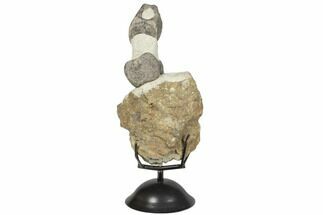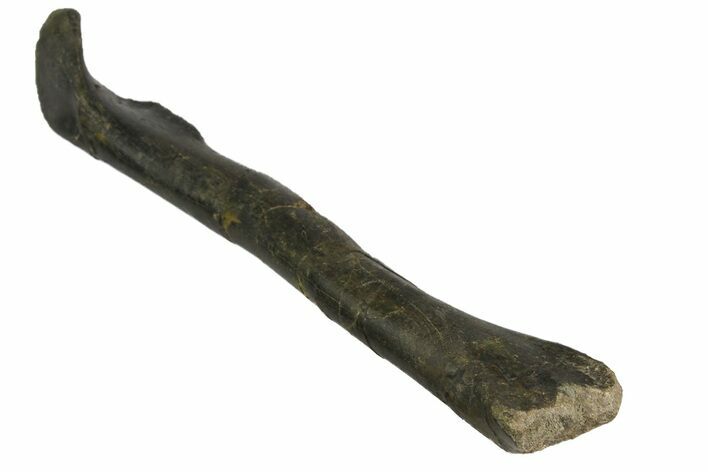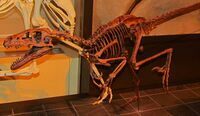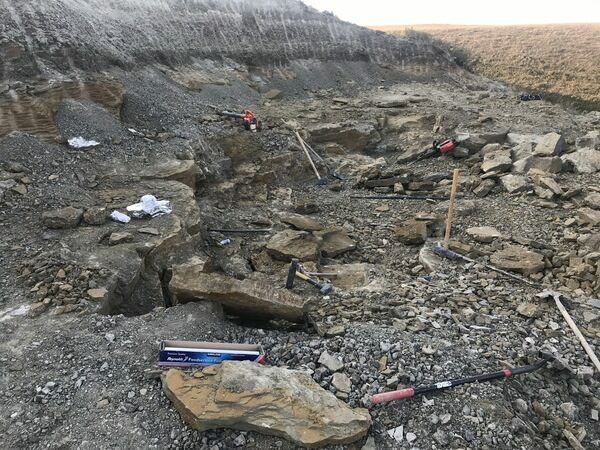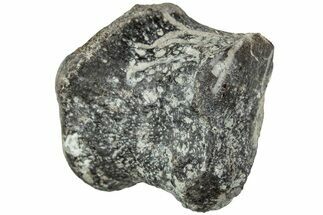This Specimen has been sold.
10.7" Raptor (Saurornitholestes?) Tibia with Metal Stand - Montana
This is a fossil tibia (right leg) of a theropod dinosaur. It was collected this past year from our partners private quarry on the Two Medicine Formation in Pondera County, Montana. It's potentially a large Saurornitholestes tibia but it's hard to confidently identify isolated bones such as this one.
The bone measures 10.7" long and stands 11.1" tall on the included custom metal display stand. There is only some gap fill restoration in the repaired cracks.
The bone measures 10.7" long and stands 11.1" tall on the included custom metal display stand. There is only some gap fill restoration in the repaired cracks.
Dromaeosaurus
was a small genus of meat-eating dinosaurs (raptors) that ripped flesh with its sickle claws and pulverized bones with a powerful bite. Its toothy grasp was suspected to be nearly three times as powerful as that of Velociraptor.
Dromaeosaurus lived during the Late Cretaceous period, sometime between 76.5 and 74.8 million years ago in the western United States and Alberta, Canada. Fossil teeth dated to 65.5 million years old may possibly belong to the genus, though these teeth are one of many mysteries that surround Dromaesaurus.
This little beastie’s name means 'running lizard'. Dromaeosaurus was a small carnivore, about 2 meters (6 feet 7 inches) in length, 15 kilograms (33 pounds) in weight, and stood 1.5 feet tall at the hips. It darted around in a world of other small theropods, ceratopsians, ankylosaurs, 30-foot hadrosaurs, and both small and massive tyrannosauroids.
The sediments they are found in select against the preservation of small theropods. Consequently, little is known about their lifestyle except what can be gleaned from the stories that their teeth reveal. We do know that they frequently shed teeth as they attacked and frenzied over their meals.
The genus is likely related to Utahraptor, as evidenced by its deadly toe claw on each foot. Dromaeosaurus varies from its relatives in some traits. It has a short, massive skull, a deep mandible, and robust teeth. The teeth tend to be more heavily worn, suggesting that its jaws were used for crushing and tearing and the giant toe claw may have had other primary uses. These details support a scavenger lifestyle, but, as already mentioned, there are few absolute conclusions regarding this robust little theropod.
Dromaeosaurus lived during the Late Cretaceous period, sometime between 76.5 and 74.8 million years ago in the western United States and Alberta, Canada. Fossil teeth dated to 65.5 million years old may possibly belong to the genus, though these teeth are one of many mysteries that surround Dromaesaurus.
This little beastie’s name means 'running lizard'. Dromaeosaurus was a small carnivore, about 2 meters (6 feet 7 inches) in length, 15 kilograms (33 pounds) in weight, and stood 1.5 feet tall at the hips. It darted around in a world of other small theropods, ceratopsians, ankylosaurs, 30-foot hadrosaurs, and both small and massive tyrannosauroids.
The sediments they are found in select against the preservation of small theropods. Consequently, little is known about their lifestyle except what can be gleaned from the stories that their teeth reveal. We do know that they frequently shed teeth as they attacked and frenzied over their meals.
The genus is likely related to Utahraptor, as evidenced by its deadly toe claw on each foot. Dromaeosaurus varies from its relatives in some traits. It has a short, massive skull, a deep mandible, and robust teeth. The teeth tend to be more heavily worn, suggesting that its jaws were used for crushing and tearing and the giant toe claw may have had other primary uses. These details support a scavenger lifestyle, but, as already mentioned, there are few absolute conclusions regarding this robust little theropod.
About The Two Medicine Formation
The Two Medicine Formation is a geographical formation in Central Montana and Southern Alberta, Canada. The formation is predominantly sandstone laid down by rivers and deltas during the Campanian Age of the Cretaceous, about 80-75 million years ago. Approximately two thousand feet thick on the western edge, it lies on top of the Virgelle Sandstone formation and under the Bearpaw Shale. It is located between the Front Range of the Rocky Mountains and the Sweetgrass Arch, a tectonic fold feature 40-90 miles east of the Front Range.
The Two Medicine is the same age as the Judith River Formation found further east. It was laid down further inland from the Western Interior Seaway, while the Judith River Formation was deposited along the coast. The Two Medicine contains much of the same dinosaur fauna, but fewer reptiles, amphibians, and aquatic fossils.
The Two Medicine Formation is a geographical formation in Central Montana and Southern Alberta, Canada. The formation is predominantly sandstone laid down by rivers and deltas during the Campanian Age of the Cretaceous, about 80-75 million years ago. Approximately two thousand feet thick on the western edge, it lies on top of the Virgelle Sandstone formation and under the Bearpaw Shale. It is located between the Front Range of the Rocky Mountains and the Sweetgrass Arch, a tectonic fold feature 40-90 miles east of the Front Range.
The Two Medicine is the same age as the Judith River Formation found further east. It was laid down further inland from the Western Interior Seaway, while the Judith River Formation was deposited along the coast. The Two Medicine contains much of the same dinosaur fauna, but fewer reptiles, amphibians, and aquatic fossils.
SPECIES
Saurornitholestes?
LOCATION
Pondera County, Montana
FORMATION
Two Medicine Formation
SIZE
10.7" long, 11.1" tall on metal stand
CATEGORY
SUB CATEGORY
ITEM
#173491
We guarantee the authenticity of all of our specimens.
 Reviews
Reviews

